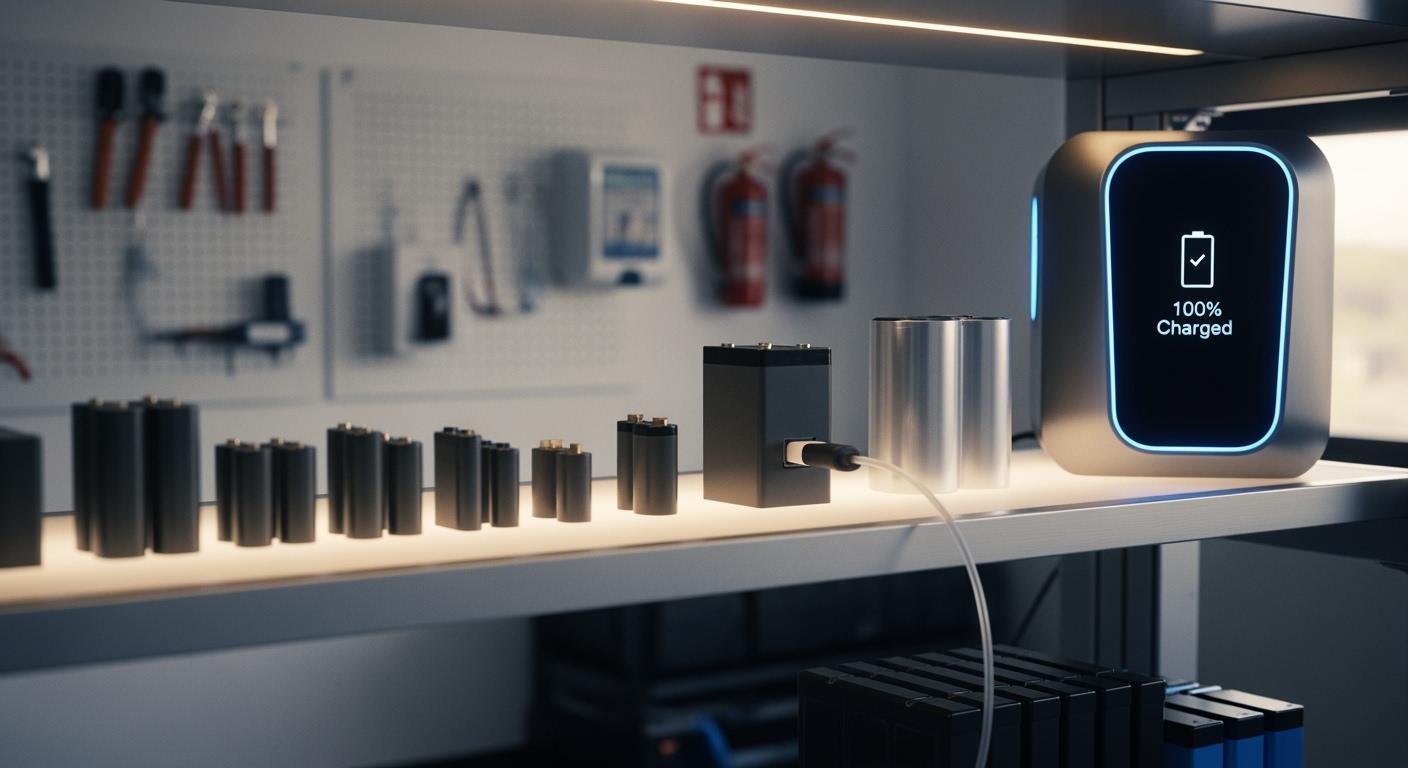
You can preserve your lithium-ion batteries with one simple rule. This action is your best defense against damage and aging.
The Solution: Keep your battery in a cool, dry place, charged to about 40-60%.
This core principle of battery storage is the most effective way to protect your investment. Following our updated 2025 tips ensures your battery storage methods are safe, helping your devices last much longer.
Achieving Optimal Storage Conditions

You can create the perfect environment for your batteries. Achieving optimal storage conditions involves controlling two key factors: charge level and temperature. These simple steps protect your lithium-ion batteries from premature aging and potential damage.
The 40-60% State of Charge Rule
Think of a battery’s charge level like its stress level. A partially charged battery is a relaxed battery. For most lithium-ion batteries, the ideal state of charge (SoC) for storage is between 40% and 60%. Research from the National Renewable Energy Laboratory (NREL) confirms this range is the sweet spot. It places the least amount of stress on the battery’s internal components. This simple action significantly slows down calendar aging, which is the degradation that happens even when the battery is not in use.
Pro Tip for LiFePO₄ Users: If you have Lithium Iron Phosphate (LiFePO₄) batteries, you have a slightly wider ideal range. Aim for a 40-70% state of charge for the best long-term battery storage results.
Dangers of Storing at 100% or 0%
Storing a battery at the extremes of its charge capacity is harmful. You should avoid it for any storage period longer than a few days.
- Storing at 100%: A fully charged battery is under high internal stress. This constant tension accelerates capacity loss. Your battery will lose its ability to hold a full charge much faster.
- Storing at 0%: A completely drained battery risks falling into a deep discharge state. In this state, the battery’s internal safety circuits can shut off permanently. This may make it impossible to recharge the battery ever again.
Proper battery storage at a partial charge avoids these issues and keeps your battery healthy.
The Importance of Cool Temperatures
Temperature is just as critical as charge level. You should store your lithium-ion batteries in a cool, stable environment.
The ideal temperature is around 15°C (59°F). A general range between 10°C and 25°C (50°F and 77°F) is also excellent. High temperatures are the enemy of battery longevity because they speed up the chemical reactions inside. This acceleration directly shortens the battery’s lifespan.
| 温度 | 对电池寿命的影响 |
|---|---|
| 15°C – 25°C | ✅ Optimal for long shelf life |
| 35°C – 40°C | ⚠️ Reduces lifespan to 5-6 years |
| >45°C | ❌ Drastically cuts lifespan to 1-2 years |
Never leave batteries in a hot car or in direct sunlight. The inside of a car can quickly exceed 54°C (130°F), causing rapid aging and increasing the risk of thermal runaway—a dangerous, uncontrolled overheating event.
Safe and Practical Storage Locations
Choosing the right location is a key part of your battery storage strategy. You need a spot that is cool, dry, and away from living spaces.
A climate-controlled garage or a dry basement often provides the perfect environment. These areas typically stay within the ideal temperature range and keep batteries safely separated from your main living quarters. If you lack these options, a utility room or an insulated closet can also work well.
For an added layer of safety, consider using specialized containers. This is one of the best practices for storing lithium-ion batteries. Look for fire-resistant battery storage bags or boxes.
Safety Certification: When buying storage containers, check for products certified to safety standards like ANSI/CAN/UL 5800. This certification ensures the product has been tested to contain a potential battery fire, giving you valuable peace of mind.
Long-Term Maintenance for Lithium-Ion Batteries
Proper battery storage is not a “set it and forget it” task. You must perform simple maintenance to ensure long-term battery health. This routine protects your lithium-ion batteries from damage and ensures they are ready for use when you need them.
The Periodic Check-Up Routine
You should check your stored batteries every three to six months. This periodic check is your main defense against permanent damage from deep discharge. During this check, you need to monitor battery charge status. If you have a multimeter, you can get a precise voltage reading. Connect the red lead to the positive terminal and the black lead to the negative one for an accurate measurement.
After checking, briefly recharge the battery. Your goal is to bring it back into that ideal 40-60% state of charge. This simple step keeps the battery active and healthy.
How to Inspect for Physical Damage
A visual inspection is a critical part of your check-up. Look closely at the battery’s casing for any signs of trouble. A damaged battery is a safety hazard and should never be used or charged.
Key warning signs include:
- Swelling or Bulging: The battery casing looks puffy or rounded.
- Cracks: Any visible cracks or splits on the surface.
- Corrosion: A white or greenish powder on the battery terminals.
- Deformation: The battery’s shape is warped, or the edges are no longer sharp.
Safety First! ⚠️ If you find a swollen or leaking battery, handle it with extreme caution. Do not charge it. Place it in a fireproof container, like a metal bucket with sand, and move it to a safe, ventilated area away from anything flammable. Contact your local e-waste facility for proper disposal instructions.
Counteracting Self-Discharge
All lithium-ion batteries naturally lose a small amount of charge over time, even in storage. This process is called self-discharge. A battery can lose 10-20% of its charge annually under ideal conditions. However, this rate is heavily influenced by temperature.
Heat is a major enemy of battery storage. The self-discharge rate can double for every 10°C (18°F) rise in temperature. Storing a battery in a hot garage or attic will cause it to lose its charge much faster. Your periodic check-up routine directly counteracts this effect by topping the battery off before its charge falls to a dangerously low level.
Critical Safety and Reuse Practices

Following correct safety and reuse procedures is essential for your battery storage plan. You protect yourself and your devices by handling lithium-ion batteries with care. These practices ensure your batteries are safe during storage and ready for action when you need them again.
Proper Physical Storage Methods
You should always disconnect a battery from its device before storing it. This simple step prevents slow power drain and potential electronic malfunctions. Proper physical handling is just as important.
- Store Upright: Always place batteries in an upright position. This helps prevent leaks and keeps internal components stable.
- Avoid Stacking: Never stack batteries on top of each other. Stacking can cause physical damage or create a connection between terminals.
- Use Organizers: Use battery racks or dedicated plastic containers. This keeps them organized, secure, and prevents them from being crushed or punctured.
Preventing Short Circuits
A short circuit is a primary safety risk. It happens when a metal object touches both the positive and negative terminals at the same time. You must keep batteries away from loose metal items like keys, coins, or tools.
Pro Tip: Insulate the terminals for maximum safety. You can place a piece of electrical tape over the contacts or put each battery in its own small plastic bag. Materials like Polyester (PET) and Polypropylene (PP) offer excellent electrical insulation and are used in professional battery storage solutions.
Safely Reusing Stored Batteries
When you are ready to use a stored battery, you need to wake it up safely. First, perform a quick visual inspection for any signs of damage, like swelling or cracks. If the battery looks fine, place it in its device or charger. Charge it slowly and fully to 100%. Monitor the battery during its first charge to ensure it does not overheat. This careful process helps the battery return to normal operation without issues.
Recalibrating After Storage
Long-term battery storage can confuse your device’s software. The battery meter might show an inaccurate reading. You can fix this by recalibrating the battery.
- Charge your device to 100% and leave it plugged in for two more hours.
- Use your device normally until the battery drains completely and it shuts down on its own.
- Finally, charge the device uninterrupted all the way back to 100%.
This cycle resets the battery’s power gauge, ensuring you see an accurate charge level.
You can protect your batteries by following a few key rules. Keep them at a 40-60% charge, store them in a cool place, and perform periodic checks. These simple habits are a small investment of your time. They significantly extend the value, lifespan, and safety of your devices. Your awareness of proper battery storage is your best tool for risk mitigation.
You now have the knowledge to get the most out of your technology and protect your devices for years to come. ✅
常见问题
Can I store batteries in the refrigerator?
You should avoid storing batteries in the refrigerator. Condensation can form inside, leading to corrosion and short circuits. A cool, dry room is a much safer choice for your batteries.
What does “cycle life” mean?
Cycle life tells you how many times you can fully charge and discharge a battery before its capacity drops significantly. Proper storage helps you get the maximum number of cycles from your battery.
A typical lithium-ion battery has a cycle life of 300-500 cycles. ✅
What should I do with old or damaged batteries?
You must never throw old batteries in the trash. ❌ They contain hazardous materials. You should take them to a designated e-waste recycling center. Many electronics stores also offer battery take-back programs.
Is it okay to leave my laptop plugged in all the time?
Leaving your laptop plugged in constantly keeps the battery at 100% charge. This high-stress state can reduce its lifespan. You should unplug it sometimes and let the battery discharge to around 40% to keep it healthy.

